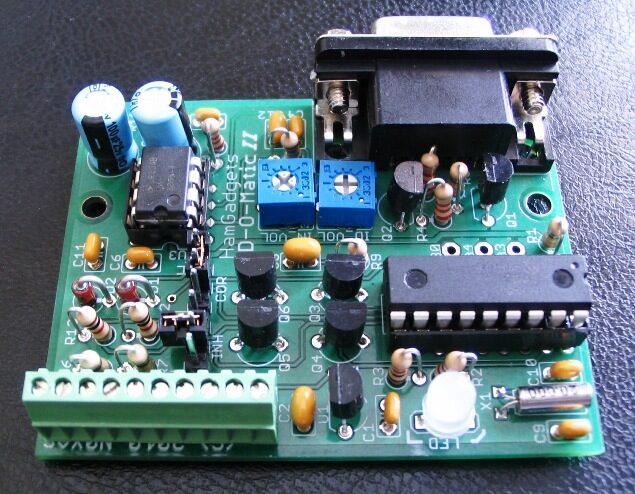– ID timer with Morse code output
– Keyed CW, audio, and PTT outputs
– PTT/audio combination for keying HTs
– 2-channel audio mixer for repeater audio & ID
– Filtering & de-emphasis for repeater audio
– Simple serial port configuration
In a nutshell, the ID-O-Matic II is the original ID-O-Matic, combined with the features of the Connection Kit and a few more, all on one board. There’s an audio amp, low-pass filtering to smooth out the sidetone, volume control and de-emphasis for external audio input, and input level converters all included on the board. In addition, all inputs and outputs are now available on a single header with a screw-clamp terminal block for quick and easy connections with no soldering.
The ID-O-Matic II is a multipurpose, PIC microcontroller based device that nearly everyone can use. Like the original ID-O-Matic featured in the 2008-2010 ARRL Handbook, it can act as a simple 10-minute timer with audio and visual outputs to remind you when it’s time to ID.
Now for the more interesting features! How about a programmable delay timer that announces your call sign or any other message, in Morse code at a speed and audio tone you choose? How about CW keying and PTT outputs so you can attach it to a “fox” transmitter, or an emergency cross-band repeater? And how about squelch/COR inputs to make a repeater IDer that works the way you want it? And how about a serial interface to connect to your shack computer, laptop or terminal for quick and easy configuration? It’s all there.
The ID-O-Matic II can meet a pretty wide range of needs. Out of the box, so to speak, it will light up a green LED until nine minutes have passed. The LED then turns yellow, and at 9 minutes 30 seconds starts blinking yellow/red. At ten minutes the ID-O-Matic beeps at you until you reset it with a pushbutton or logic signal, then starts over.
But of course this would be a little overkill for a simple 10-minute timer! Using the built-in RS232 serial interface, connect the ID-O-Matic II to a terminal or a PC with a terminal emulation program (PuTTY, Hyperterminal, Minicom, etc) and you can use the simple menu to set your own delay from 1 to 65535 seconds (over 9 hours). You can control when (and if) the LED turns yellow and when it starts blinking. You can also choose between the default beep, or just type in your call sign or any other message up to 64 characters long to hear it in Morse code. When in CW ID mode the ID-O-Matic II will send the message, then automatically reset and start timing again.
You can also select repeater mode. In repeater mode two additional inputs can be used to control when ID-O-Matic II sends your selected Morse code ID. You can use a squelch, COR, PTT or other signals of your choosing. Built-in input level converters let you use either active-high or active-low signals. You can optionally have the ID-O-Matic send a courtesy beep at the end of each transmission (with user-selected delay), and you can specify a PTT “hang time” to keep PTT active for a few seconds after the input stops. If you want the repeater to ID every so often when it’s idle, there is a beacon timer and a separate message for that too. You can, for example, have the repeater ID with its call sign while being used, and a longer message every hour or two when it’s idle. There’s a PTT watchdog timer to keep your repeater from being “hung” by stuck mic buttons (or long-winded users). And, you can use the ALT MSG input to send a different ID message based on the state of an input signal – useful if, for example, your site switches to backup power.
Regardless of the mode used, the PTT output is active 100ms before and 100ms after the CW ID. Speed is variable from 5 to 40 words per minute, and the audio pitch for the CW ID and the courtesy beep is also variable via the menu. Both the CW and PTT outputs are equipped with robust 2N7000 MOSFETs that can handle up to 60V at up to 200 mA to key transmitters or other loads.
Improvements have been made to the original ID-O-Matic’s Morse audio output. Where the old chip used a square wave signal, the new one uses pulse-width modulation followed by a low-pass filter to generate a much smoother, much better sounding audio signal.
The on-board Morse ID is filtered and fed to an LM386 audio amplifier. An input is provided for external audio from you r receiver or other source; this input is also amplified and mixed with the Morse audio. You can optionally install the parts for a simple R-C de-emphasis filter on the external audio input. On board trim pots adjust the volume of each audio source.
The ID-O-Matic II kit includes the ID-O-Matic chip along with a high quality, double-sided PCB with silkscreen and solder mask. All parts needed to build the board are included including the terminal block. A speaker is not included, but the on-board LM386 audio amp can drive your speaker. All you need to supply is an enclosure and a source of power. If you want to see the instructions before ordering, just click this link or see the Docs section of the web site for a PDF copy.
Price: $25 USD

